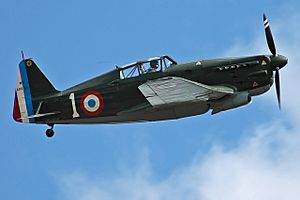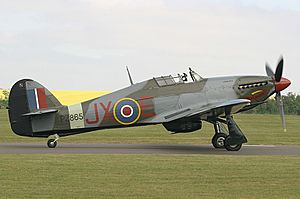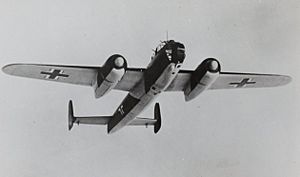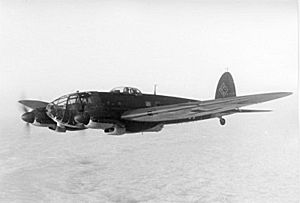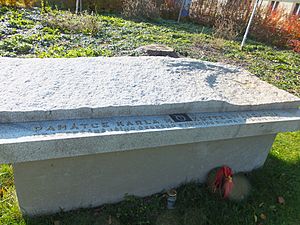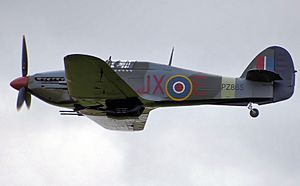Karel Kuttelwascher facts for kids
Quick facts for kids
Karel Miloslav Kuttelwascher
|
|
|---|---|
| Nickname(s) | Kut Czech Night Hawk |
| Born | 23 September 1916 Svatý Kříž, Bohemia, Austria-Hungary |
| Died | 17 August 1959 (aged 42) St Austell, England |
| Buried |
Uxbridge, England
|
| Allegiance | |
| Service/ |
Czechoslovak Air Force French Foreign Legion French Air Force |
| Years of service | 1934–46 |
| Rank | Squadron Leader |
| Unit | 44 Fighter Unit 32 Fighter Unit |
| Commands held | "A" Flight, No. 1 Squadron RAF |
| Battles/wars | Second World War |
| Awards |
|
| Other work | British European Airways pilot |
Karel Miloslav Kuttelwascher was a brave fighter pilot from Czechoslovakia. He was born on September 23, 1916, and passed away on August 17, 1959. He became a "flying ace" for the Royal Air Force (RAF) in the UK during World War II. A flying ace is a pilot who shoots down five or more enemy aircraft.
Karel, often called "Kut," was the most successful Czechoslovak pilot in the RAF. He was also one of the RAF's top-scoring flying aces overall. During his time with the RAF, he shot down 18 enemy planes. He might have shot down even more planes when he flew for the French Air Force, but those records are not complete.
Karel fought in battles from May 1940 to October 1942. After the war, he returned to Czechoslovakia in 1945. However, he moved back to Britain in 1946. There, he became a pilot for a civilian airline called British European Airways. He sadly died from a heart attack in 1959 when he was 42 years old.
Contents
Becoming a Pilot: Karel's Early Life
Karel Kuttelwascher was born in 1916 in a village called Svatý Kříž. This village is now part of Havlíčkův Brod in the Czech Republic. He was the third of six children in his family.
When he was 17, Karel started working as a clerk at a flour mill. On October 1, 1934, at age 18, he joined the Czechoslovak Air Force. He trained hard and became a qualified pilot in March 1937. He was then sent to the 4 Flying Regiment near Prague.
Karel finished his fighter pilot training in May 1938. He joined the 32nd Fighter Unit, which protected the skies over Moravia and Slovakia.
Escaping to Freedom
On March 15, 1939, Germany occupied Czechoslovakia. The Czechoslovak Air Force was disbanded the next day. Karel knew he had to escape to continue fighting.
On the night of June 13, Karel and six other Czechoslovaks secretly left on a coal train. They traveled from Ostrava to Bohumín, a town that Poland had taken over. They reported to the Czechoslovak Consulate in Kraków, Poland. They stayed in a temporary camp there.
On July 29, 1939, Karel and his group went to the Port of Gdynia. They boarded a Swedish ship, the Kastelholm, to travel to France. Some Polish officials tried to convince them to stay and join the Polish Air Force. A few pilots, like Josef František, decided to stay after flipping a coin. But Karel and most of the others stuck to their plan to go to France. On July 30, they arrived in Calais, France.
Fighting for France: Karel's Service
At that time, the French Air Force could not directly enlist people who were not French citizens. But the Czechoslovak Ambassador in Paris made a deal. Czechoslovak volunteers could join the French Foreign Legion for five years. The agreement was that if war started, they would be released to form a Czechoslovak army.
Karel and his group joined the Foreign Legion. They were sent to Algeria in North Africa for army training and to learn French.
Joining the French Air Force
On September 3, 1939, France and the United Kingdom declared war on Germany. On November 17, the French Government and the Czechoslovak government-in-exile agreed. Czechoslovak airmen would transfer from the Foreign Legion to the French Air Force. This was until a Czechoslovak air force could be formed.
Karel was one of about 100 pilots sent to a fighter training base. He quickly learned to fly the Morane-Saulnier M.S.406C.1 fighter. On May 17, 1940, he joined a combat squadron called Groupe de Chasse III/3.
Four days later, his squadron moved and received newer Dewoitine D.520C.1 fighters. As German forces advanced in the Battle of France, Karel's squadron had to keep moving to new airfields.
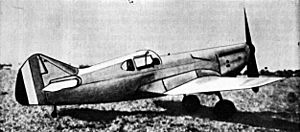
Karel claimed he destroyed or damaged several enemy planes while with the French Air Force. French records from that time are not complete. But surviving records confirm he shot down two planes and probably one more.
On June 22, 1940, France surrendered to Germany. The French Air Force released its Czechoslovak pilots on July 1. Karel and other Czechoslovaks traveled to Casablanca in Morocco. They were gathering there to escape to the UK. On July 9, they left Casablanca on a ferry. They reached Gibraltar and then sailed to Cardiff, Wales, arriving on August 5.
Becoming a Night Hawk: RAF Service
After a short stay in a camp, Karel Kuttelwascher joined the RAF on August 14, 1940. He was given the rank of flight sergeant. He then went to a training unit where he learned to fly the Hawker Hurricane.
Hurricane Pilot with No. 1 Squadron
On October 3, 1940, Karel joined No. 1 Squadron RAF. This squadron flew the Hurricane Ia. He fought in the later part of the Battle of Britain. In December, his squadron moved to RAF Northolt and flew missions over northern France.
On February 2, 1941, Karel might have shot down a Messerschmitt Bf 109 fighter. On April 8, 1941, he got his first confirmed kill in the RAF. He shot down a Bf 109 near Cap Gris Nez. He shot down another Bf 109 on May 21 and a third on June 27. By summer, he was promoted to flight lieutenant.
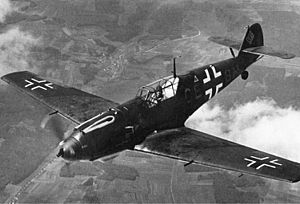
In 1941, Karel met Beryl Ruby Thomas at a dance. They got married in 1942.
On February 12, 1942, No. 1 Squadron attacked German destroyers in the English Channel. These destroyers were protecting two large German battleships. Karel's squadron lost two planes, but he managed to damage one of the destroyers with his powerful 20mm cannon.
Night Intruder Missions
No. 1 Squadron then moved to RAF Tangmere and got a new job: night intruder missions over France. These were dangerous missions where a single plane would try to shoot down German bombers over their own airfields. The Hurricanes did not have radar, so these missions were only flown during a full moon. They required amazing flying skills, excellent eyesight, and great courage.
The squadron used Hawker Hurricane Mk IIc planes, painted black for night flying. Each plane had extra fuel tanks, allowing them to fly for about 3 to 3.5 hours. They had two 20mm cannons on each wing, but only enough ammunition for about nine seconds of firing!
Karel's Hurricane IIc was named BE581 and had the code letters "JX-E". It also had a special symbol: a yellow scythe with a red banner that said "Night Reaper." Karel had the most successful attacks of any night intruder pilot.
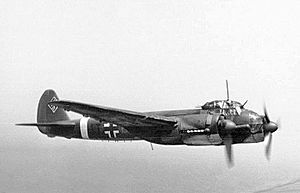
On the night of April 1, 1942, Karel got his first night intruder victories. He shot down one Junkers Ju 88 and damaged another. On April 16, he shot down a Dornier Do 217 bomber. His next victories were another Do 217 and a Ju 88. On the night of April 30, he shot down a Do 217 and a Heinkel He 111 bomber. On May 4, Karel shot down three He 111s in just four minutes!
On June 2, Karel shot down a Do 217. The next night, he shot down two He 111s and a Do 217, and damaged another Do 217. On June 21, he shot down a Ju 88 and damaged a second. On June 28, 1942, Karel shot down a Do 217E-4, killing its crew. On July 1, he shot down two Do 217s and damaged a third.
No. 1 Squadron destroyed 21 enemy planes in three months. Karel Kuttelwascher alone had shot down 15 of them and damaged five more. For this, he received the Distinguished Flying Cross. News reporters nicknamed him the "Czech Night Hawk."
Karel's brave actions greatly boosted the spirits of his countrymen back home. His story, including a personal interview, was even broadcast on the BBC.
Later RAF Service
On July 8, 1942, Karel was moved to No. 23 Squadron RAF. This squadron flew the de Havilland Mosquito Mk II, which had radar. Karel flew six missions with his navigator, P/O GE Palmer, but they did not shoot down any enemy planes.
In October 1942, Karel stopped flying combat missions. He was transferred to the Czechoslovak Air Inspectorate in London. From June to December 1943, he spent six months in the US and Canada. His main job was to try and recruit Czech and Slovak Americans and Canadians to join Czechoslovak units in the UK armed forces. He also gave talks about the air war in Europe to the US and Canadian air forces.
When he returned, Karel became a test pilot at RAF St Athan in Wales. He tested various types of bombers until the war ended.
Life After the War
By the end of the war, Karel and his wife Ruby had a son and twin daughters. Karel returned to Czechoslovakia in August 1945, and his family followed shortly after. He rejoined the Czechoslovak Air Force and was promoted to Staff Captain. He became an instructor at the Air Force Academy.
Ruby found it hard to adapt to life in Czechoslovakia. In January 1946, she returned to England. Karel became worried about the growing power of the Communist Party of Czechoslovakia. He applied for a visa to return to the UK, which he eventually received. On May 21, 1946, he left the air force. Five days later, he returned to Britain.
Back in the UK, Karel first flew light aircraft to keep his skills sharp. Then, he joined British European Airways as a first officer. Karel and Ruby divorced in 1951. In 1955, Karel started a greengrocery business, but he kept flying. He became a British citizen in January 1956. In the same year, he was promoted to captain.
On August 13, 1959, Karel was on holiday in St Austell, Cornwall, when he had a heart attack. He was taken to the hospital. Sadly, on the night of August 17, he had a second, fatal heart attack. He is buried in Uxbridge, Middlesex.
Karel's Achievements and Awards
Karel Kuttelwascher had 18 confirmed air victories during World War II. In 1942, a high-ranking air marshal called him one of "The greatest figures among our fighter pilots."
Karel's actual total might have been even higher. Some sources say he had 20 victories, including planes he shot down with the French Air Force. He was the RAF's highest-scoring Czechoslovak pilot. He was also the most effective night intruder pilot and the sixth-most-successful night fighter pilot overall.
Awards and Recognition
Karel Kuttelwascher received many awards from Czechoslovakia, the UK, and France:
 Czechoslovak War Cross 1939–1945 five times
Czechoslovak War Cross 1939–1945 five times Československá medaile Za chrabrost před nepritelem (Bravery in Face of the Enemy)
Československá medaile Za chrabrost před nepritelem (Bravery in Face of the Enemy) Československá medaile za zásluhy, 1. stupně (Medal of Merit, First Class)
Československá medaile za zásluhy, 1. stupně (Medal of Merit, First Class) Pamětní medaile československé armády v zahraničí (Commemorative Medal of the Czechoslovak Army Abroad) with France and Great Britain Bars
Pamětní medaile československé armády v zahraničí (Commemorative Medal of the Czechoslovak Army Abroad) with France and Great Britain Bars Distinguished Flying Cross and bar
Distinguished Flying Cross and bar 1939–1945 Star with Battle of Britain clasp
1939–1945 Star with Battle of Britain clasp Air Crew Europe Star
Air Crew Europe Star Defence Medal
Defence Medal War Medal 1939–1945
War Medal 1939–1945 French Croix de Guerre with one palm and one silver star
French Croix de Guerre with one palm and one silver star
After his death, the Czech Republic honored Karel Kuttelwascher. He was promoted to Brigadier General in 2000. In 2016, he was awarded the Order of the White Lion. There are now monuments to him in his home village. A street in Prague is also named "Kuttelwascherova" after him. In 2017, the Czech Mint even made special silver and gold coins to honor him.
Battle of Britain Memorial Flight Hurricane
In 2005, the RAF Battle of Britain Memorial Flight painted one of its Hawker Hurricane PZ865 planes. It now carries the "JX-E" code letters. This was done to honor Karel Kuttelwascher and his famous "Night Reaper" Hurricane BE581.


